

Designation:VQ-6 Vandal Veritech Alpha Drone |
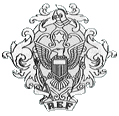
|
||||
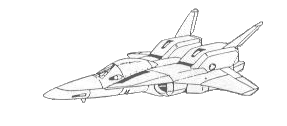
|
|||||
Designation:VQ-6S ASAVAN (aka 'Shadowdrone') |

|
||||
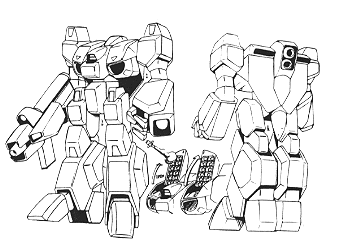
|
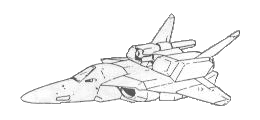
|
||||

| Fighter | Guardian | Battloid | |
|---|---|---|---|
| Total Length : | 10.25m | 8.00m | - |
| Total Depth : | - | - | 5.25m |
| Total Height : | 4.60m | 5.72m | 8.75m |
| Total Breadth : | - | 4.84m | 4.84m |
| Total Wingspan : | 8.20m | - | - |
| Total Dry Weight: | 16.70 tons (metric) (VQ-6) | ||
| 16.95 tons (metric) (VQ-6S) | |||
Cannons (VQ-6A, -6B, -6C):
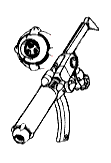
|
Cannons (VQ-6S):
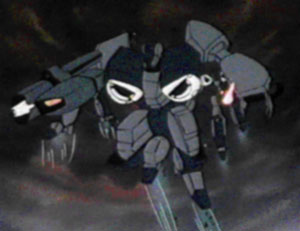
|
| Location | Missiles | Modes available |
|---|---|---|
| 1/ shoulder(2) | 8 ea. | F,G,B |
| 2/ arm(4) | 5 ea. | G,B |
| 2/ outside of leg(4) | 4 ea. | G,B |
| 1/ inside of leg(2) | 4 ea. | F,G,B |
| (F = Fighter, G = Guardian, B = Battloid mode) | ||
| Location | Missiles | Modes available |
|---|---|---|
| 1/ collar(2) | 12 ea. | F,G,B |
| 2/ arm(4) | 5 ea. | G,B |
| 2/ outside of leg(4) | 4 ea. | G,B |
| 1/ inside of leg(2) | 4 ea. | F,G,B |
| (F = Fighter, G = Guardian, B = Battloid mode) | ||
The armor on the Alpha series fighters is a new development in low-mass composite-materials Chobham plating that became the standard for all Terran mecha after its application to the VQ-6A Vandal. Aside from the respectable protection provided against projectiles, missiles, and other kinetic weapons, this armor is also resistant to plasma globes (annihilation discs), lasers, and to a lesser extent, particle guns, owing to the fact that the armor can flake off and evaporate in layers under fire from such high-energy weapons, taking much of the weapon's energy and converting it into the latent heat of sublimation in the armor. The armor stops all small arms and heavy infantry weapons fire, provides good to excellent resistance to light mecha-mounted weaponry, such as the Zentraedi 22.3mm HE autocannon round, and poor to good resistance to medium mecha-mounted weaponry, such as the Valkyrie's 55mm APFSDS round.
The armor on the Vandal is marginally inferior to that mounted on the later VF-6 models, like the VQ-6S.
The Drones are unmanned and hence do not have a cockpit.
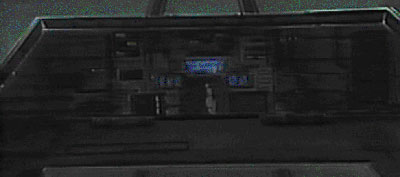
The Vandal drone is a retro-fitted Alpha fighter with the cockpit, cyclone stowage and head pulled and replaced with a semi-autonomous control system that required a remote control station.
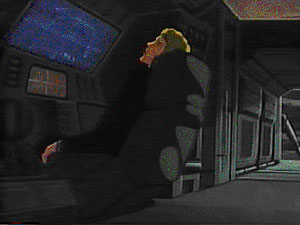
The VQ-6A Vandal was the drone that preceded the first Alphas in service. The piloting hardware is an improved variant of the Mark 3 Heuristic expert system used on the QF-3000E Ghost, but tactical management of multiple fighters is controlled by a ground-based C&C emplacement (usually the M-9 ACC) which communicates with the fighters via Low Probability of Intercept (LPI) radio transmission.
EF investigation of battle encounters with the Invid suggested that Invid bases had a unique sensor device that managed to pick up EF battle formations at strategically significant distances in situations that would inhibit normal sensors. In other words, Invid hives, troopships, and their relatively uncommon capital vessels could detect capital vessels or mecha attack groups at extreme ranges, and could locate and track the largest of them through small celestial bodies, or at significant distances below the horizon. The combination of this mixed long- and medium-range sensor capability made tactical misdirection and surprise completely impossible, and strategic approach extremely difficult.
The Robotech Research Groups on Tirol immediately went to work on sorting out this sensor's operating principles and devise, if possible, a counter to it. The tight link of the Invid with protoculture gave a probable pointer to the nature of the Invid's device, and quite soon after that the RRG groups discovered that active protoculture-powered devices gave off a detectable radiation. For nearly two decades, methods to counter or mask this radiation were explored, with much frustration and little success. The first notable approach involved the Wide Dispersal Bio-Emulator, often referred to merely as a 'protoculture flare', a mine-sized device that used a single protoculture cell at maximum yield to emulate the characteristic protoculture radition of a much larger mecha. In large numbers, the protoculture emulators could act as a decoy against the Invid hive sensors. Variants of this device were also occasionally issued to Special Forces units.
Eventually, at about the time plans were being made to dispatch a fleet to Earth to investigate its long silence, the RRG groups developed a so-called 'shadow' generator, which effectively red-shifted the spectral emissions of the protoculture radiation beyond the Invid's sensor acuity.
Unfortunately for the First and Second Earth Reclamation Fleets, the Invid on Earth had recently developed a vastly more sensitive version of this sensor and began to install smaller versions of this sensor even into their mecha. Now, the combined hive- and mecha-sensors could detect single mecha at long ranges, and localize them - or even detect single Cyclones - at medium ranges. Even protoculture-powered small arms could no longer escape detection. It was these new variants of the sensor that allowed the Invid to completely suppress all early actions of the resistance movements on Earth, as well as insuring the quick and total destruction of both the fleets sent to Earth, and the mop-up of survivors.
However, because of the sharpness of the peak in the protoculture's emission spectrum, the 'shadow' generator needed only slight modifications to be made to be effective against the more sensitive protoculture sensors of the Regess' armies. As soon as the working prototypes were developed in early 2043, the REF decided incorporate this stealth feature into their next generation of combat mecha; a newer fighter based on the Alpha, and an advanced Alpha drone.
As these mecha were designed, the opportunity was taken to equip them with an advanced version of an EM masking skin, which had a 'stealth' effect on more conventional sensors. These new additions to the tried-and-true Alpha design were not without their price; the Shadow device required the replacement of the flip-out sensor/ECM pod by a more compact internal model, and the removal of the original VTOL thrusters, which were located on the lower fuselage in fighter mode, and at the chest and groin in Battloid. In their place were stored the new electronics and coolant systems. The latter were needed because of the fact that a 'shadow' aircraft would, in many space environments, quickly heat up to well over the boiling temperature of water even with all systems powered down, due to the fact that the skin absorbed most incident radiation, and only inefficiently radiated away its heat. Inside an atmosphere, convection with the outside air eliminates this problem, but in space, the pilots would have simply baked. Thus a reservoir of coolant, usually liquid nitrogen, was used to cool the fighter, some of it being passed through a network of capillaries in the skin of the plane to absorb heat, before being dumped in the engine's intermix chamber. If the coolant ran out, the plane's reaction mass (usually water) could be rerouted into the capillaries for the same purpose, but this was less efficient.
Furthermore, the EF wanted to equip their new front-line mecha with more technological innovations, including the force-field disrupting Destabilizer particle beam and a virtual cockpit. The first designs for this cockpit called for a non-transparent canopy, but this led to protests from the pilots, who wanted to retain some visibility. However, it turned out to be possible to project the virtual world on the inside of a thinly gold-layered canopy, which also left some outward visibility, and prevented the cockpit from becoming a radar-reflecting cavity.
The culmination of these efforts was the 'Shadowfighter', or the VF-6S Shadow Alpha. In addition to the inclusion of the stealth features, and the associated loss of the fighter-mode VTOL capability, and the addition of the semi-virtual cockpit, the Shadowfighter saw minor redesigns on the intakes and shoulders, as well as the deletion of some of the secondary and redundant sensor suites on the legs. In addition, the hands were replaced with three-fingered claws.
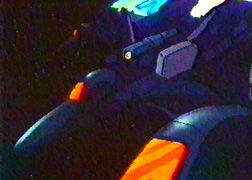
Because of manpower shortages, the designers also conceived and built a new drone version of the Alpha fighter, this time equipped with a vastly improved control system compared to the one installed in the VQ-6A Vandal. This version of the Alpha was designated the VQ-6S ASAVAN (from Advanced Stealth Alpha Veritech AutoNom, but also from an Avestan word that translates roughly as "righteous one" or "upholder of moral order"), though it was more popularly known simply as the "Shadowdrone". The 'brain' of this mecha was the first practical application of the REF's AI research team in almost twenty-five years, and in that time, quantum leaps in learning systems technology had been made. The Mk83 Neural Net Learning System CPU was modeled on, and is roughly equivalent in capability to, the central nervous system of a Terran lupine, and like a real brain, the two hemispheres work in tandem. Beginning its existence in a simulator, the final prototype of the CPU was trained in a wide variety of tasks, including flight, movement, combat, and recognition of and obedience to authority. It was also taught rudimentary communication using a mission-specific vocabulary including via both visual and radio cues. After proficiency was achieved, the CPU was mass-produced with the 'trained' neural connections already built-in, and the pre-trained CPUs were installed in fighters, and were then subjected to further training in their new bodies. The CPUs continue to learn by experience during their entire lifetimes, eventually developing a simple animal-level personality. Periodically, squadrons of fighters are called back in for retraining, to insure that newly-learned experiences do not cause loss of discipline or of basic skills. This retraining involves more conventional exercises, like those human pilots might be subjected to, as well as reviews in simulators of selected excerpts from manned fighters' and other ASAVANs' flight recorders. In combat operations, several ASAVANs are attached as wingmen to a piloted craft, which serves an analogous role to a wolf pack's alpha male. In case of separation from the leading Alpha, the VQ-6S's neural net controller can operate the vehicle independently, with an efficiency dependent upon the unit's level of experience. Field experience shows that under these circumstances, the orphaned Shadowdrones will rally around the nearest piloted craft, or, if one can not be immediately found, the most experienced of the nearby drones, until a piloted craft can be sent to assume leadership.
The AI autopilot does not eliminate the need for an ACS (Automatic Control System), which handles almost all of the routine functions the corresponding system manages in the piloted Alphas, such as sensors, threat detection and identification, countermeasures, and so forth; making the pilot interface as simple to the CPU as it is to a human pilot - with the exception of motor control of the mecha, which in the case of the ASAVAN, is directly connected to the 'brain'.
At the beginning of each new production run, the most experienced, disciplined, and skilled ASAVANs are recalled. Their CPUs are scanned, and their neural connections - in a sense, their experiences - copied into the new basis for the next generation pre-trained CPUs. These new ASAVANs begin service as a mental 'clone' of the parent CPU they were copied from, but diversify as yet more experiences are acquired.
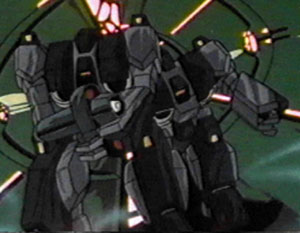
Because of the lack of a pilot, the ASAVAN's cockpit could be deleted. The canopy was removed in favor of a solid hull with similar contours, with a multi-optics package in the forward quarter of former canopy. The legs are more similar to the old Alpha's than the Shadowfighter's are, though the "toe" section was redesigned slightly. The central torso is virtually identical to the Shadowfighter, though the area analogous to the human collarbone now includes dual twelve-tube SRM launchers on flip-up racks above the intakes. The shoulders were redesigned again, with the placement of forward-facing sensors packages in place of the shoulder missile launchers. Below the shoulders, the arms were identical to those on the Shadowfighter, including the three-fingered claws and the capability to carry the Destabilizer. The head was completely removed from the Battloid, and in its place, a primary sensor array was situated between and above the intakes, above where the old Alpha's chest-mounted VTOL thruster had been located. Though the groin and chest thrusters of the old Alpha are still missing, the Shadowdrone was refit with VTOL capability. Because of the enormous volume freed up in the nose sections by the removal of the pilot and the dual fighter/Battloid mode cockpits, the two VTOL thrusters were placed in the nose section. In fighter mode, they occupy the approximate location of the old Alpha's head, but in Battloid, they are on the nape of its headless neck. Finally, the winglets on the Alpha and Shadowfighter that extend from just fore of the canopy to the intakes where they joined with the wings, were completely removed from the ASAVAN.
Both Alpha Shadow versions were used in the Jupiter and Saturn Group attacks on Reflex Point, with most VQ-6S drones remaining 'upstairs' with the fleet. The Shadow Fighters performed very well against the Invid, and only the Invid's immense numerical advantage caused the near defeat of the EF armada.
During the last stages of the Third Robotech War, and afterwards, the Shadow Fighters were the most important Terran mecha, and the later ASAVAN generations also played a distinguished role in Earth's militaries. Production of the VF-6S at Tirol already numbered more than fifteen hundred by the departure of Third Earth Reclamation fleets, and later the RNF and TRN produced thousands more in their planetside factories.
Return to EF Veritech Index.
Return to Robotech Reference Guide Home Page.
Robotech (R) is the property of Harmony Gold. This document is in no way intended to infringe upon their rights.
Content by Pieter Thomassen and Peter Walker